Featured Articles
In Celebration of Miguel Cotto
Miguel Cotto entered his dressing room at Barclays Center on the night of June 6 at 8:25 PM.
He was casually dressed, wearing faded blue jeans, a well-worn gray T-shirt, a blue leather jacket, and loafers with no socks.
There was a time when winning a world championship was boxing’s equivalent of a mobster becoming a made man. No more. In an era characterized by multiple sanctioning bodies and more than a hundred world “champions” at any point in time, only a handful of fighters matter to the public.
Miguel Cotto matters.
There has been a premium in the new millenium on trash-talking and glitz. That’s not Cotto’s way.
Miguel has always respected the sport of boxing and its practitioners. “I am where I am in boxing because I work hard instead of complaining,” he says. “I don’t ask for anything I didn’t earn.”
He would have been respected as a fighter in any era.
Cotto’s journey through boxing began in 1992.
“I was a chubby child,” Miguel recalls. “I weighed 162 pounds at age eleven. My sport was to sit in front of the TV and eat. I started boxing to lose weight and fell in love with it.”
Cotto has been fighting professionally for fourteen years. At his peak, he was a destructive force, devastating good fighters like Zab Judah, Carlos Quintana, and Paulie Malignaggi and outpointing great ones like Shane Mosley. He learned English at a late age to improve his marketability. Then something bad happened.
On the morning of July 26, 2008, Cotto had a 32-0 record and was ranked in the top five on most pound-for-pound lists. That night, he stepped into the ring at the MGM Grand in Las Vegas to face Antonio Magarito and suffered a horrific beating. The weight of the evidence strongly suggests that Margarito’s gloves were “loaded” that night.
After that, Miguel wasn’t the same fighter. On November 14, 2009, he absorbed another beating at the hands of Manny Pacquiao. Thereafter, he fought sporadically, earning victories over Yuri Foreman, Ricardo Mayorga, and Margarito (in a rematch) before being outpointed in back-to-back losses to Floyd Mayweather and Austin Trout.
After the loss to Trout, Cotto’s days as a star attraction seemed to be over. On October 5, 2013, he scored a third-round knockout over Delvin Rodriguez. But Rodriguez has won only four of eleven fights dating back to 2008, so that didn’t count for much in the eyes of the boxing establishment.
Then, on June 7, 2014, Cotto challenged Sergio Martinez for the middleweight championship of the world.
Cotto knocked Martinez down three times in the first stanza. The fight was stopped after nine lopsided rounds. But it was an open issue as to whether Miguel had looked good or Sergio (who’d undergone extensive knee surgery prior to the fight and would require more surgery afterward) looked bad.
The victory over Martinez brought Cotto’s record to 39 wins against 4 losses with 32 knockouts and gave him renewed bargaining power. In January of this year, he signed a lucrative three-fight contract with Roc Nation that included a substantial signing bonus, a contribution by the promoter to Miguel’s charity in Puerto Rico, and an agreement between Roc Nation and Cotto Promotions to co-promote a series of boxing cards and rock concerts on the island.
In the aftermath of the signing, there were harsh words from Todd DuBoef of Top Rank (Cotto’s former promoter). At a February 5, 2015, luncheon to formally announce the deal, a reporter asked Gaby Penagaricano (Miguel’s attorney) about DuBoef’s negative comments.
“I am going to be the only one to talk about it,” Miguel interrupted. “We had a fight by fight deal with Top Rank. I expect respect, and a lot of people I knew from the beginning of my career didn’t show that.”
Later, when asked if there was any lingering bitterness between him and Top Rank, Miguel answered, “ If they want to say hi to me, they have my number.”
Cotto’s opponent at Barclay’s Center was Daniel Geale.
Geale (31-3, 16 KOs) had been competitive in past outings against fighters like Darren Barker, Anthony Mundine, and Felix Sturm. But when last seen in New York, he’d been knocked out by Gennady Golovkon in three rounds in a fight that evoked images of a bug flying into the windshield of a 16-wheel truck on an interstate highway.
“I didn’t come here for a holiday,” Geale said of his impending confrontation with Cotto. “I came here to fight.”
But Daniel (a 5-to-1 underdog) had been brought in on the assumption that he would lose. He was a respectable but “safe” opponent. Not too fast, not too skilled, not a big puncher. He wouldn’t bring anything to the table that Miguel couldn’t deal with.
Furthering Cotto’s advantage, the fight was to be contested at a catchweight of 157 pounds although Miguel’s 160-pound title was at stake. But the belt was of secondary importance. In a world inundated with phony belts and make-believe champions, this was a Miguel Cotto fight.
Barclays Center is the home of the NBA Brooklyn Nets. Cotto was treated like visiting royalty. Geale had been given an ordinary dressing room. Team Cotto was ensconsed in the Nets suite.
The dressing area was a spacious enclosure, thirty-six feet long and thirty feet wide with a twelve-foot-high ceiling and recessed lighting above. A white Brooklyn Nets logo was woven into plush black carpet. There were twelve separate dressing stations, each one with its own vertical closet, sliding drawer, and swivel chair. The last name and number of a Nets player was on a placard affixed to the wall by each station. The rest of the suite consisted of a lounge, lavatory, shower room, whirlpool room, and medical area.
For the first two hours after Cotto’s arrival, well-wishers came and went. Family members and friends, sanctioning body officials, representatives of Roc Nation. Through it all, the core group remained the same. Trainer Freddie Roach, assistant trainer Marvin Somodio, cutman David Martinez, strength and conditioning coach Gavin MacMillan, and Bryan Perez (Miguel’s closest and most trusted friend).
Former New York Yankee great Bernie Williams (who’d been asked by Miguel to walk him to the ring) sat quietly to the side.
The mood was relaxed, almost festive.
Cotto doesn’t smile often in public. He’s self-controlled and gives the impression of being on guard at all times. One might describe him as “stoic” (a person who endures hardship and pain without complaint and rarely shows his true feelings). But Miguel has expressive eyes that, depending on the moment, can be soft, hard, thoughtful, happy, lonely. His smile is genuine and warm.
Miguel smiles more in the dressing room on fight night than he does at press conferences and other media events. As time passed, he chatted casually with Perez, Somodio, and others as though he were circulating at a cocktail party. Other times, he sat alone with his thoughts or paced wordlessly with his arms folded, sipping from a bottle of water.
There were the normal pre-fight rituals supervised by New York State Athletic Commission inspectors George Ward and Sue Etkin. Referee Harvey Dock gave Cotto his pre-fight instructions. Miguel applied underarm deoderant before putting on his boxing gear and checked his smart phone for messages.
Times have changed. It’s hard to imagine Rocky Marciano checking a smart phone for messages in the dressing room before a fight.
At 9:00 PM, the salsa music of Ismael Miranda wafted through the air, adding to the festive aura.
Trainer Freddie Roach stood off to the side. Cotto-Geale was the third fight that he and Miguel had prepared for together.
In an earlier incarnation, Roach compiled a 39-and-13 ring record as a combatant. He’s still every bit as much a fighter as the men he trains. But now he’s fighting a different kind of battle, against the ravages of Parkinson’s syndrome.
Miguel calls Freddie “the best thing that ever happened to my career” and says, “Freddie brought confidence back to me. He comes every day to the gym and gives his best. The only way you can pay a person like that back is to give your best.”
Now Roach was reflecting on the time he has spent with Cotto.
“Miguel has a great work ethic,” Freddie said. “Once he’s in the gym, it’s all work. He’s one of the most disciplined fighters I’ve seen in my life. He’s very quiet. Every now and then, he tells a joke. He’s a pleasure to work with.”
“The biggest thing when I started with Miguel,” Roach continued, “was, I said to him, ‘When you were an amateur, you were a boxer. Why are you throwing every punch now like you want to kill the other guy? It’s not enough to have skills. It’s not enough to have heart. You have to fight smart.’ And Miguel listened. He tries to do what I tell him to do. You’ll see that tonight. I don’t know if Geale will come at us and try to impose his size or run all night. Either way, he’ll keep his hands high. That’s what he always does, so we’ll attack the body.”
Roach went down the hall to watch Geale’s hands being wrapped.
Cotto began stretching his upper body and leg muscles.
At 9:30, Marvin Somodio started wrapping Miguel’s hands, right hand first.
Miguel whistled in tune with the music as Somodio worked.
“Miguel loves fight night,” Bryan Perez said. “He’s enjoying the moment.”
Roach returned.
“Geale got a terrible handwrap,” Freddie announced. “I don’t think his guy knows how to wrap hands. The way he did it, there’s not much protection or strength.”
That led to Roach reminiscing about an oddity that occurred years ago when he was training Virgil Hill.
“I went in to watch the opponent getting his hands wrapped, and the guy who was wrapping had no idea what he was doing. Finally, the fighter said, ‘Freddie, will you wrap my hands?’ I said, ‘I can’t. You’re fighting my guy.’ He said, ‘Please!’ So I did it.”
At 9:50, Cotto lay down on a towel on the floor and Somodio began stretching him out.
Miguel shadow-boxed briefly.
Somodio gloved him up.
At 10:27, Miguel began hitting the pads with Roach; his first real physical exertion of the night. Four minutes later, they stopped.
At 10:40, a voice sounded: “Okay, guys.”
It was time to fight.
This was Cotto’s first fight at Barclays Center after having fought once at Yankee Stadium and nine times at Madison Square Garden.
Geale had a decided size advantage. One day earlier earlier, Miguel had weighed in at 153.6 pounds (under the junior-middleweight limit), while Daniel tipped the scales at 157. During the ensuing thirty hours, Geale had gained approximately twenty pounds. He weighed 182 in street clothes on fight night. But size was his only edge.
Cotto-Geale was a craftsman versus an ordinary fighter. It was clear from the start that Miguel was faster and the better boxer.
For the first three rounds, Cotto piled up points with his jab and scored points in addition to doing damage with hard hooks to the body. Thirty-two seconds into round four, a picture-perfect left hook up top smashed Geale to the canvas and left him on his back with his upper torso stretched beneath the bottom ring rope.
Daniel rose on unsteady legs at the count of nine and managed to stay upright for another thirty seconds before a barrage of punches punctuated by a short right hand deposited him on the floor for the second time.
Once again, he beat the count.
“Are you okay?” referee Harvey Dock asked.
Geale shook his head.
“No,” he said.
Dock appropriately stopped the fight.
There was joy in Cotto’s dressing room after the fight. It wasn’t that he’d beaten Geale as much as the way he beaten him that impressed.
“Miguel boxed very well tonight,” Roach said. “The angles were good. He got off first and went to the body a lot.” Freddie smiled. “It’s a lot easier when the fight happens the way you planned it.”
As for the future; Cotto isn’t one of the kids anymore. He’s much closer to the end of his ring career than the beginning.
“I said that I would be out of boxing by the time I am thirty,” Miguel noted recently.” I am thirty-four now.”
How many fights he has left will depend in large measure on how much punishment he takes in them and, to a lesser degree, how much each training camp takes out of him.
Meanwhile, June 6 was one more performance to be treasured. But in some ways, it was just another fight. Miguel showered and put on the same faded jeans, gray T-shirt, blue leather jacket, and loafers without socks that he’d worn earlier in the evening. He looked like a factory worker getting ready to go home after an honest night’s work.
Thomas Hauser can be reached by email at thauser@rcn.com. His most recent book – Thomas Hauser on Boxing – was published by the University of Arkansas Press.
-
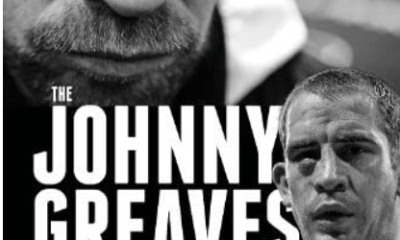
 Featured Articles3 weeks ago
Featured Articles3 weeks agoThomas Hauser’s Literary Notes: Johnny Greaves Tells a Sad Tale
-
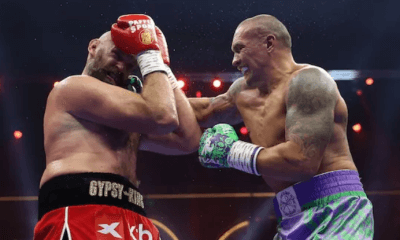
 Featured Articles2 weeks ago
Featured Articles2 weeks agoBoxing Notes and Nuggets from Thomas Hauser
-
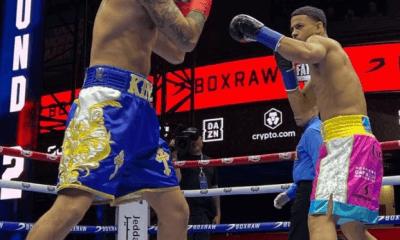
 Featured Articles4 weeks ago
Featured Articles4 weeks agoRolly Romero Upsets Ryan Garcia in the Finale of a Times Square Tripleheader
-
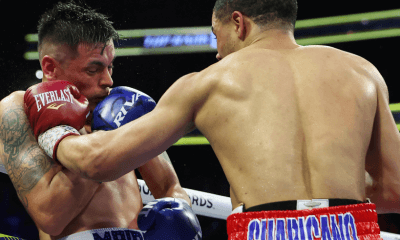
 Featured Articles4 weeks ago
Featured Articles4 weeks agoUndercard Results and Recaps from the Inoue-Cardenas Show in Las Vegas
-

 Featured Articles4 weeks ago
Featured Articles4 weeks agoCanelo Alvarez Upends Dancing Machine William Scull in Saudi Arabia
-

 Featured Articles4 weeks ago
Featured Articles4 weeks agoBombs Away in Las Vegas where Inoue and Espinoza Scored Smashing Triumphs
-
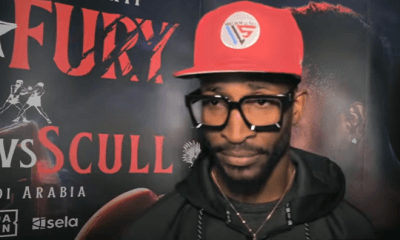
 Featured Articles4 weeks ago
Featured Articles4 weeks agoArne’s Almanac: The Good, the Bad, and the (Mostly) Ugly; a Weekend Boxing Recap and More
-
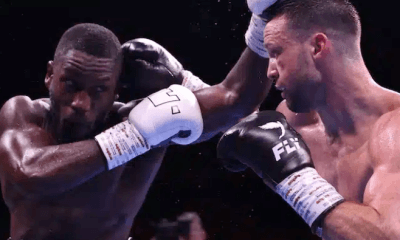
 Featured Articles1 week ago
Featured Articles1 week agoEkow Essuman Upsets Josh Taylor and Moses Itauma Blasts Out Mike Balogun in Glasgow




















1 Comment